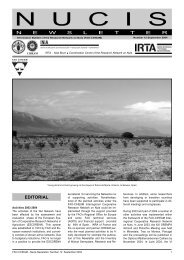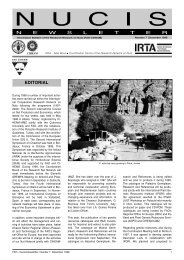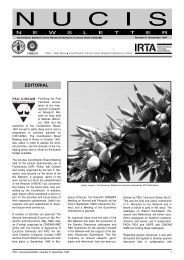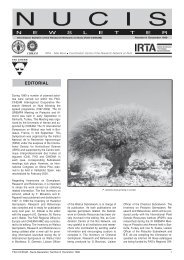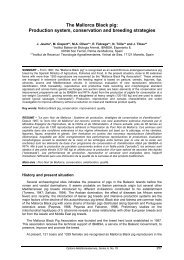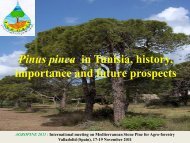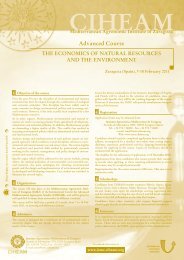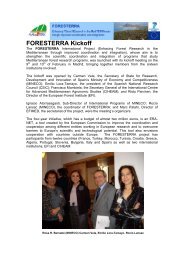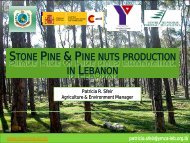NUCIS number 10. December 2001. 48 pages (full ... - IAMZ - ciheam
NUCIS number 10. December 2001. 48 pages (full ... - IAMZ - ciheam
NUCIS number 10. December 2001. 48 pages (full ... - IAMZ - ciheam
Create successful ePaper yourself
Turn your PDF publications into a flip-book with our unique Google optimized e-Paper software.
THE AUSTRALIAN PISTACHIO<br />
INDUSTRY<br />
The motivation for the Australian pistachio<br />
industry developed out of concern in<br />
the 1960s over poor financial returns to<br />
grape growers. The government put resources<br />
into developing alternative crops<br />
such as pistachios. That the Australian<br />
wine grape industry is now extremely profitable<br />
and expanding rapidly says something<br />
about the cyclical nature of agriculture<br />
and also something about the ability<br />
of governments to pick winners in its industry<br />
policy. However, the Australian<br />
pistachio industry is the result. The industry<br />
is still small, less than 500 hectares<br />
with 2001 production reaching almost<br />
1,000 metric tons. However, after almost<br />
20 years of commercial farming, the opportunities<br />
are now there for significant<br />
expansion.<br />
In the 1960s an introduction and selection<br />
programme was commenced by the research<br />
arm of the Australian government,<br />
CSIRO, to identify pistachio varieties suitable<br />
for Australian conditions. The land<br />
and water available in Australia suitable<br />
for pistachios tend to have lower chill<br />
hours than the traditional pistachio<br />
growing regions of the world. The criteria<br />
for selection were high, consistent yields<br />
of good quality nuts with high split rates,<br />
under Australian conditions.<br />
From a large <strong>number</strong> of seedlings and imported<br />
clones, CSIRO selected an open<br />
pollinated seedling of ‘Red Aleppo’. The<br />
‘Red Aleppo’ used came from the UC collection<br />
at Chico, California. ‘Red Aleppo’<br />
is described in the original CSIRO publication<br />
as “an important Syrian variety”.<br />
Syrian growers today claim not to know of<br />
it. Brooks and Olmo describe ‘Red Aleppo’<br />
as an old cultivar from Syria or Turkey<br />
that was introduced into California by R.A.<br />
Fuller. They continue saying it may be a<br />
seedling of Turkish or Syrian ‘Red Aleppo’.<br />
In the early 1980’s CSIRO released<br />
the selected clone and named it ‘Sirora’.<br />
Cultivar ‘Sirora’ has a <strong>number</strong> of desirable<br />
characteristics.<br />
• It has a very high split rate in commercial<br />
production, 90 to 97% is typical.<br />
• It has an excellent green kernel colour<br />
and good flavour.<br />
• It will produce reasonably well even in<br />
years with poor chilling hours (1,000) although it is much<br />
worse in low chilling years. Nut maturity is<br />
spread over three weeks from the end of<br />
February to the end of March. Growers<br />
with large orchards double shake ‘Sirora’<br />
trees to maximise the return of clean shell,<br />
split nuts with the shakers about 10 to 16<br />
days apart.<br />
Small areas of ‘Kerman’ are also grown.<br />
Yields are typically 55% to 65% of the ‘Sirora’<br />
yield. Non-split rates are very high,<br />
typically 15-25%.<br />
The rootstocks used are: P. terebinthus,<br />
P. atlantica and Pioneer Gold (P. integerrima).<br />
Whilst Verticillium wilt (V.dahlia) is<br />
'Sirora' cluster at harvesting time in Mildura, Australia<br />
22 FAO-CIHEAM - Nucis-Newsletter, Number 10 <strong>December</strong> 2001



